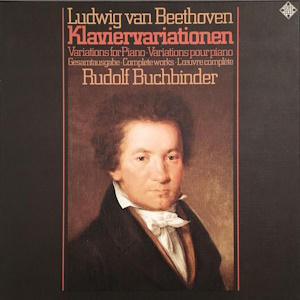 |
|
6 LPs
- 6.35289 FK - (p) 1976
|
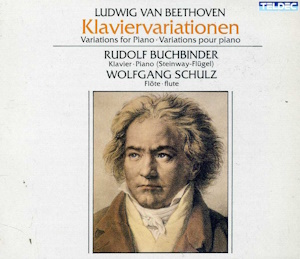 |
| 5 CDs -
8.35818 XA - (p) 1988 |
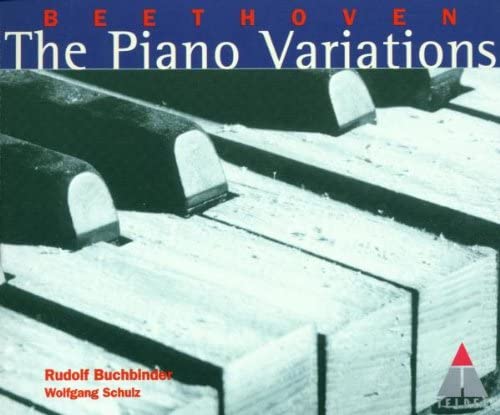 |
| 5 CDs -
3984-21797-2 - (p) 1998 |
|
| KLAVIERVARIATIONEN
- GESAMTAUSGABE |
|
|
|
|
|
|
|
| Ludwig
van BEETHOVEN (1750-1827) |
|
|
|
|
|
|
|
Neun Variationen
über einen Marsch von Ernst
Christoph Dressler - c-moll,
WoO 63 (1782)
|
|
14' 44" |
A1
|
Sechs leichte
Variationen über ein Schweizer
Lied - F-dur, WoO 64 (um 1790)
|
|
3' 06" |
A2 |
Acht Variationen
über das Lied "Ich hab' ein
kleines Hüttchen nu"
|
|
6' 36" |
A3 |
Vierundzwanzig
Variationen über die Ariette
"Venni amore" con Vincenzo Righini
- D-dur, WoO 65 (1790)
|
|
22' 14" |
B1 |
Dreizehn
Variationen über die Ariette "Es
war einmal ein alter Mann" aus
dem Singspiel "Das rote Käppchen"
von Carl Ditters von Dittersdorf -
A-dur, WoO 66 (1792)
|
|
12' 47" |
B2 |
|
|
|
|
Zwölf Variationen
über das "Menuett à la Viganò"
aus dem Ballett "Le nozze
disturbate" von Jakob Haibel -
C-dur, WoO 68 (1795)
|
|
14' 35" |
C1
|
Neun Variationen
über das Thema "Quant'è più bello"
aus der Oper "La Molinara" von
Giovanni Paisiello - A-dur, WoO 69
(1795)
|
|
5' 21" |
C2 |
| Sechs Variationen
über das Duett "Nel cor più non mi
sento" aus der Oper "La
Molinara" von Giovanni Paisiello -
G-dur, WoO 70 (1795) |
|
5' 37" |
D1 |
Zwölf Variationen
über den russischen Tanz aus dem
Ballett "Das Waldmädchen" von
Paul Wranitzkz - A-dur, WoO 71
(1796)
|
|
11' 28" |
D2 |
Acht Variationen
über das Thema "Une fievre
brulante" aus der Oper "Richard
Cœur de Lion" von
Andrè-ernest-Modeste Grètry - C-dur,
WoO 72 (1796)
|
|
6' 20" |
D3 |
|
|
|
|
Zehn Variationen
über das Thema "La stessa, la
stessissima" aus der Oper
"Falstaff" von Antonio Salieri
- B-dur, WoO 73 (Januar 1799)
|
|
11 24" |
E1 |
Sieben
Variationen über das Quartett
"Kind, willst du ruhig schlafen"
aus der Oper "Das unterbrochene
Opferfest" von Peter Winter - F-dur,
WoO 75 (1799)
|
|
11 11" |
E2 |
Acht Variationen
über das Terzett "Tändeln und
scherzen" aus der Oper
"Soliman II" von Franz Xaver Süßmayr
- F-dur, WoO 76 (Herbst 1799)
|
|
8 20" |
F1 |
Sechs leichte
Variationen über ein eigenes Thema
- G-dur, WoO 77 (1800)
|
|
7 12" |
F2 |
Sieben
Variationen über das englische
Volksied "God save the King" -
C-dur, WoO 78 (1803)
|
|
8 36" |
F3 |
Fünf Variationen
über das englische Volkslied "Rule
Britannia" - D-dur, WoO 79
(1803)
|
|
5 21" |
F4 |
|
|
|
|
Zweiunddreissig
Variationen über ein eigenes Thema
- c-moll, WoO 80 (1806)
|
|
11' 36" |
G1 |
Sechs Variationen
- F-dur, Op. 34 (1802)
|
|
15' 21" |
G2 |
Fünfzehn
Variationen mit einer Fuge -
Es-dur, Op. 35 (1802)
|
|
24' 47" |
H1 |
Sechs Variationen
- D-dur, Op. 76 (1809)
|
|
5' 55" |
H2 |
|
|
|
|
Sechs variierte
Themen für Klavier mit Begleitung
von Flöte, Op. 105 (1817/18) *
|
|
19' 50" |
I1 |
| Zehn variierte
Themen für Klavier mit Begleitung
von Flöte, Op. 107 * |
|
44' 36" |
J2 |
|
|
|
|
Dreiunddreissig
Veränderungen übe einen Walzer von
Anton Diabelli - C-dur, Op.
120 (1819-23)
|
|
55' 55" |
K-L |
|
|
|
|
Rudolf BUCHBINDER,
Klavier (Steinway-Flügel)
Wolfgang Schulz, Flöte
*
|
|
|
|
|
|
Luogo
e data di registrazione |
|
-
|
|
|
Original
Editions |
|
Telefunken
| 6.35289 FK | 6 LPs | LC 0366 |
durata: 59' 27" · 43' 21" · 52'
04" · 57' 39" · 64' 26" · 55' 55"
| (p) 1976 | ANA | stereo
|
|
|
Edizione CD
|
|
Teldec | 8.35818
XA | 5 CDs | LC 3706 | durata
67' 51" · 67' 35" ·
71' 54" · 64' 40" · 62' 31"
| (c) 1998 | AAD | stereo
Teldec | 3984-21797-2 | 5 CDs | LC
6019 | durata 67' 51" ·
67' 35" · 71' 54" · 64' 40" ·
62' 31" | (c) 1998 |
ADD | stereo | Remastered
|
|
|
Executive
Producer |
|
-
|
|
|
Recording
Engineer |
|
-
|
|
|
Cover |
|
Ludwig
van Beethoven, Gemälde von J. W.
Mähler, 1815
|
|
|
Note |
|
- |
|
|
|
|
|
BUCHBINDER
& BEETHOVEN

6 LPs - 6.5289 FK - (p) 1976
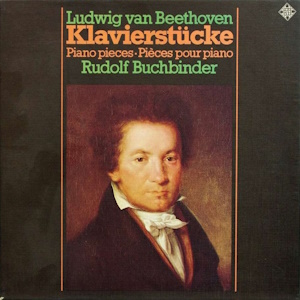 6 LPs - 6.35368 FK
- (p) 1977
6 LPs - 6.35368 FK
- (p) 1977
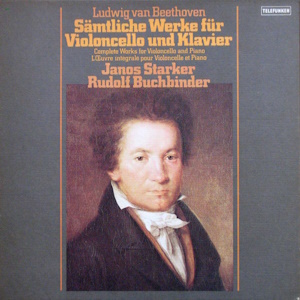
3 LPs -
6.35450 EX - (p) 1978
|
Beethoven's
Piano Variations
In the course of
their lifetime, many great artists
have developed a preference for a
genre or a form which let them
unfold their creative powers to
their best advantage. Schubert is
known for his songs, Wagner for
his operas. Beethoven’s name
immediately makes us think of his
symphonies, sonatas and quartets.
But when Beethoven was a young
virtuoso, his imagination, as well
as that of his contemporaries, was
sparked above all by
improvisations, fantasies and
variations. Beethoven seems to
have enjoyed improvising already
at a very early age: as a
four-year-old, he was enjoined by
his father to play the music in
front of him if he ever wanted to
achieve success. A few years
later, when Beethoven was eleven,
it was his Variations on a March
by Ernst Christoph Dressler, which
was published on the initiative of
the boys teacher, Christian
Gottlob Neefe. Neefe wanted thus
to encourage his pupil to
persevere in this genre, for “he
would certainly become a second
Wolfgang Amadeus Mozart if he were
to continue the way he has begun."
Beethoven's contemporaries felt
that his original use of
ornaments, his motivic
developments and his own mode of
expression were truly special and
unique features in his music. In
one of the first letters the
composer sent from faraway Vienna
in 1795 to a friend from his early
Bonn years, Eleonore von Breuning,
Beethoven wrote: “I have often
observed that from time to time
there was someone in Vienna who,
when in the evening I had been
improvising, usually spent the
next day transcribing and preening
himself with many of my
idiosyncrasies.” The esteem which
Beethoven enjoyed at that time
emerges from a statement by Wenzel
Johann Tomaschek, who heard the
composer play in Prague in 1798
when Beethoven was asked to
improvise freely on a theme from
Mozart's La Clemenza di Tito:
“Beethoven’s magnificent playing.
and particularly the daring
flights of his improvisation,
stirred me strangely to the depths
of my soul, to the extent that I
could not touch my piano for
several days.” What fascinated
Beethoven's contemporaries so much
- his ability to constantly derive
new material from his sources and
to effect changes even in the most
minute elements - also extended to
language: he manipulated words no
differently than he did themes,
motives and figures.
Variations were the form in which
the elevenyear-old composer cast
his first published work; they
were also the form of one of the
mightiest works of his later
years, the famous Diabelli
Variations. Beethoven
believed in a simple and
straightforward elaboration of his
own well-balanced themes as well
as of the popular Viennese
melodies of the day. This is
underscored by a striking
observation the composer made
about a work that had been
presented to him: “Your variations
betray a certain structure, but
what I object to is that you have
varied the theme. Why? What people
are fond of should not be taken
from them; this also means
changing even before any
variations have been made."
The piano was the instrument of
Beethoven‘s imagination, and the
variation was his predilected
vehicle, the form. Although
Beethoven excluded the majority of
his piano variations from the
regular numbering of his works, it
is a documented fact that he did
this deliberately The present-day
numbering according to WoO numbers
is based on a modern work
catalogue. The critical restraint
which, incidentally, Beethoven
also exercised on a number of
other officially numbered works,
does not impair the effectiveness
or value of his variations; on the
contrary, there is no genre better
suited to one’s becoming
acquainted with the “hits” of the
day than the variation. And there
is no better domain to illustrate
Beethovens skill and abilities as
a cosmopolitan and as a pianist -
for he was also esteemed as a
noted piano virtuoso. Finally, it
is important to understand the
works from which Beethoven
borrowed his themes as part of his
musical “surroundings.” it often
happened that Beethoven's creative
energy was sparked by this kind of
music, and that he found in it the
stimulus for new musical creations
which fascinated people in his own
time and continue to do so today.
Hans
Schmidt (1976; revised in
1998)
Translation:
Roger Clement
|
|
|
|